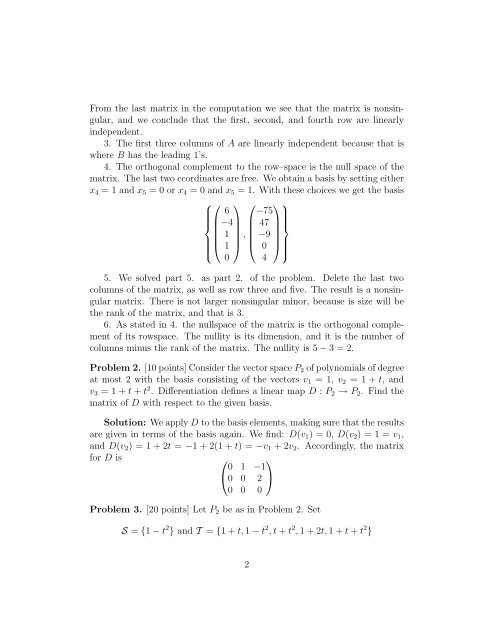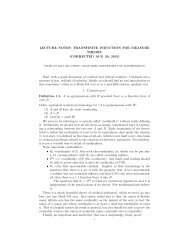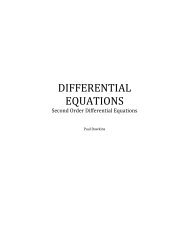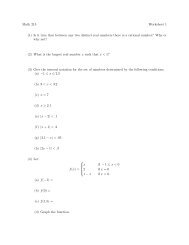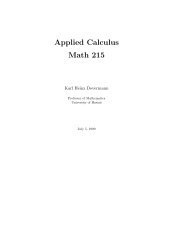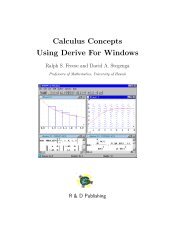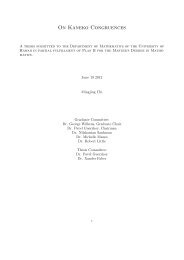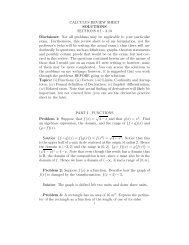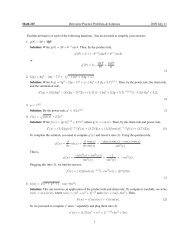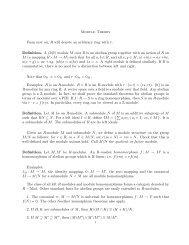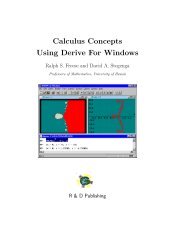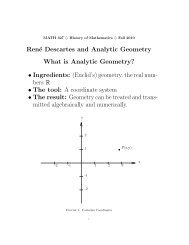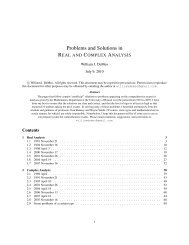Create successful ePaper yourself
Turn your PDF publications into a flip-book with our unique Google optimized e-Paper software.
From the last matrix in the computation we see that the matrix is nonsingular,<br />
and we conclude that the first, second, and fourth row are linearly<br />
independent.<br />
3. The first three columns of A are linearly independent because that is<br />
where B has the leading 1’s.<br />
4. The orthogonal complement to the row<strong>–</strong>space is the null space of the<br />
matrix. The last two ccordinates are free. We obtain a basis by setting either<br />
x4 = 1 and x5 = 0 or x4 = 0 and x5 = 1. With these choices we get the basis<br />
⎧⎛<br />
⎞<br />
6<br />
⎪⎨ ⎜<br />
⎜−4<br />
⎟<br />
⎜ 1 ⎟<br />
⎝<br />
⎪⎩<br />
1 ⎠<br />
0<br />
,<br />
⎛ ⎞⎫<br />
−75<br />
⎜ 47 ⎟⎪⎬<br />
⎟<br />
⎜ −9 ⎟<br />
⎝ 0 ⎠<br />
⎪⎭<br />
4<br />
5. We solved part 5. as part 2. of the problem. Delete the last two<br />
columns of the matrix, as well as row three and five. The result is a nonsingular<br />
matrix. There is not larger nonsingular minor, because is size will be<br />
the rank of the matrix, and that is 3.<br />
6. As stated in 4. the nullspace of the matrix is the orthogonal complement<br />
of its rowspace. The nullity is its dimension, and it is the number of<br />
columns minus the rank of the matrix. The nullity is 5 − 3 = 2.<br />
Problem 2. [10 points] Consider the vector space P2 of polynomials of degree<br />
at most 2 with the basis consisting of the vectors v1 = 1, v2 = 1 + t, and<br />
v3 = 1 + t + t 2 . Differentiation defines a linear map D : P2 → P2. Find the<br />
matrix of D with respect to the given basis.<br />
Solution: We apply D to the basis elements, making sure that the results<br />
are given in terms of the basis again. We find: D(v1) = 0, D(v2) = 1 = v1,<br />
and D(v2) = 1 + 2t = −1 + 2(1 + t) = −v1 + 2v2. Accordingly, the matrix<br />
for D is ⎛ ⎞<br />
0 1 −1<br />
⎝0<br />
0 2 ⎠<br />
0 0 0<br />
Problem 3. [20 points] Let P2 be as in Problem 2. Set<br />
S = {1 − t 2 } and T = {1 + t, 1 − t 2 , t + t 2 , 1 + 2t, 1 + t + t 2 }<br />
2


